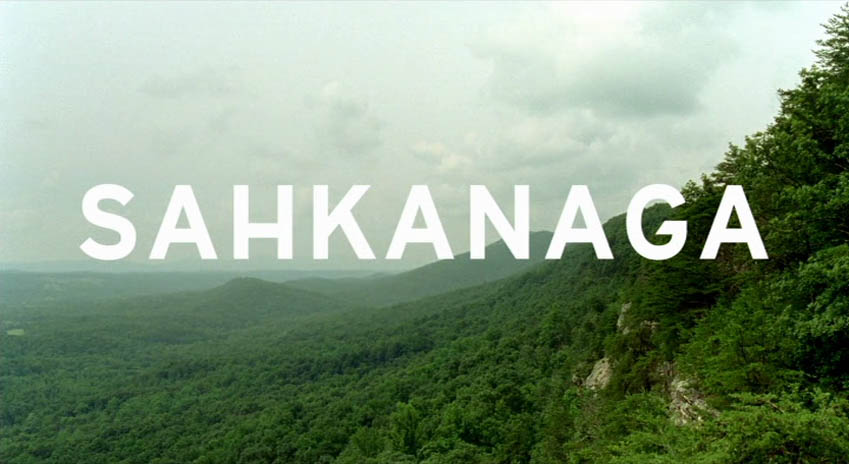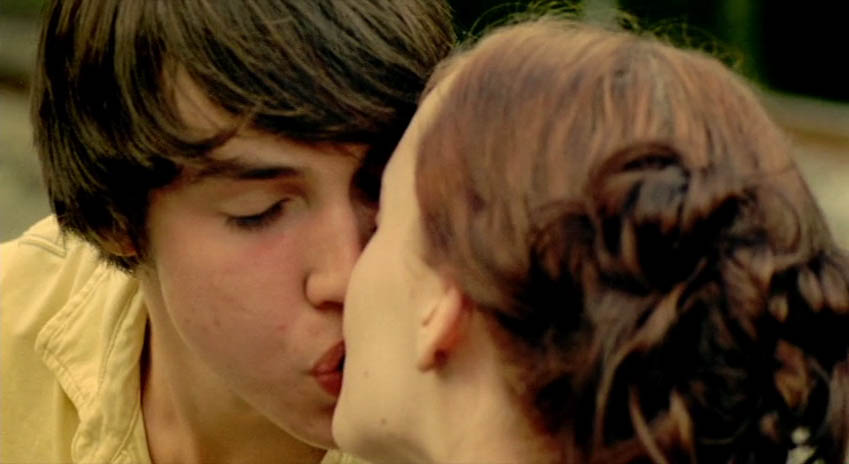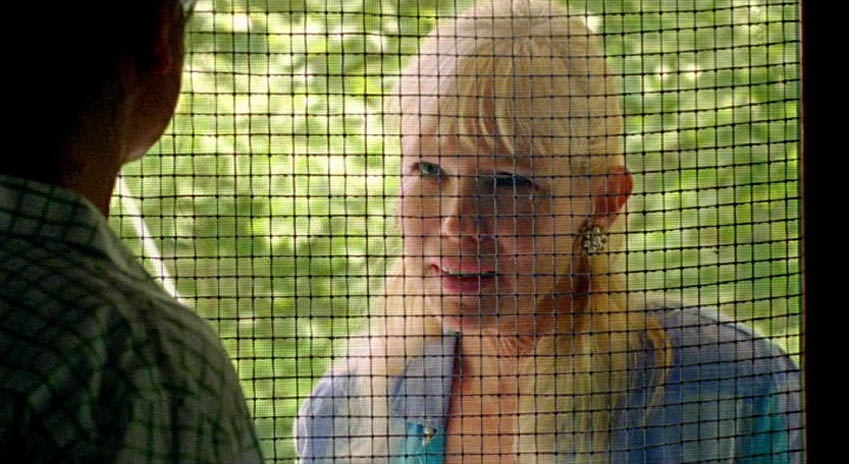Seen & Unseen: The Inner World of Sahkanaga

My post here today is a little off-topic from the usual genealogy and local history focus here at Jordan’s Journey. But what I want to talk about is relevant in a roundabout, artistic way.
This past weekend I saw Sahkanaga. Sahkanaga is an unusual film for me to watch. Not because of anything to do with the film itself, but for the fact that I happen to be from the county where it was filmed–and where the Tri-State Crematory tragedy (which the film uses as a backdrop for its coming-of-age story) happened.
I told you this post was a bit off-topic for this blog, but hear me out. I think this will be worth your time.
Sahkanaga was written and directed by John Henry Summerour, also from Walker County. Mr. Summerour is, like me, a Georgian expatriate who moved away to New York City and became an artist. Candidly speaking, I think something about growing up in a place like Walker County makes you want–need–to flee it. In the film, Lyla asks Paul, “Do you like it here?”
“Sometimes I think it’s just a really big hole, you know,” Paul responds. “I’m trapped down here. I just want to scream at the top of my lungs so that someone will hear me, send me a ladder or something, save me and get me out of here, you know.”
I couldn’t have said it better myself. Luckily, for both Summerour and myself, we made it out.
But–and I say this with all sincerity–I don’t mean to sound condescending. We both came back to Walker County as artists and created something for our homeland. Summerour has managed to make a film about the angst of growing up in a place where he was misunderstood–the same place where I was misunderstood–yet portrays such immense love and respect for the community. I feel a lot of parallels with Jordan’s Journey here. Jordan’s Journey is much more than a book of genealogy and local history. It’s an art book through and through. It just so happens to use real people and places fused together with detailed academic research and filters it all through the lens of art. The viewer doesn’t have to see it this way, but almost everyone–upon actually seeing the book for the first time–recognizes that it’s something way beyond your usual genealogy tome. Whether or not a viewer/reader has the language to understand it as art–that’s ok. I have always felt that the interpretation is in the eye of the beholder when it comes to art.
I see a lot going on in Sahkanaga. On the surface, it’s a fictional retelling of a real story that happened in Walker County. Many people see it as a coming-of-age story that just happens to be set in the South. And both of these things are certainly true. But it’s also a very serious and deeply personal piece of film art. In this way, it functions as a commentary on the director’s relationship to his hometown. And given that John and I have so much in common, it feels like a story I could have told in many ways. Like the old adage, “It takes one to know one,” I think John and I are two artists who see Walker County in a similar light.
As I watched the film, I couldn’t help but analyze some of its more formal aspects. How do you tell a personal story about your hometown through the lens of a very public, emotionally charged, national-news-worthy story? It’s not an easy task to pull off, but Summerour manages to tell the story with such aplomb that, I believe, his film helps the community understand the Tri-State Crematory tragedy better than ever before.
The storytelling device that stood out to me the most is the exploration of the struggle between the interior and the exterior. The film examines many aspects of private life versus public life. Early on you see this when Scotty reveals to Paul how the sheriff had treated him in private. This is actually a minor detail in the story, but it sets the stage that, behind closed doors, people aren’t always what they seem. What goes on inside isn’t what’s assumed by the outside.

When Paul and Lyla have their first kiss, it’s an innocent, simple kiss outdoors. Soon, though, they return to Paul’s house. Summerour injects a bit of humor into what is almost an adolescent rite of passage as Paul brings Lyla into his home, showing her the house room by room. It’s a ritualistic shift from the exterior of their first kiss to the interior of Paul’s home. As they begin to make out in Paul’s bedroom, the phone rings. This is another important part of the film. The young couple is interrupted by the phone–an abrupt disruption from the exterior world into the interior world of Paul and Lyla.
This tension is explored throughout the film. We see it later–again in the form of the telephone–when Lyla and Lovey are having dinner at home. Lovey gets up from the table to turn off the phone. She takes control and prevents the exterior from penetrating the interior space. The camera cuts to Paul’s family, also at dinner, where the telephone also intrudes.
“Why isn’t the answering machine picking up,” Paul asks.
“We turned it off.”
“Why?”
“Because it’s full.”
This invasion from the outside world has overwhelmed the family. Nerves continue to fray as the phone rings throughout the scene.

To make the interior/exterior distinction perfectly clear, Sandy instructs her daughter, “I don’t want you to leave the house without us.” The implication is that home is a safe/private place, but the outside world is dangerous and cannot be trusted.
When Paul and Lyla finally make love, they sneak off one night to the funeral home run by Paul’s parents. Sex is the ultimate private act. Paul and Lyla make love by candlelight. Too bad they didn’t have some black out curtains because a cop notices the glow from outside. He calls Paul’s father, who goes inside to check it out. This intrusion is a thematic climax (ok, pun intended, I couldn’t pass that one up now could I?).

Paul’s father brings his son home, and not unexpectedly, a family argument ensues. But this time Paul stands up for himself. In this coming-of-age moment, Paul admits what he got his family–his community–into. And for the first time he takes responsibility for that action.
In one of the film’s several poetic voiceovers, Paul himself contemplates the “outside in”:
Is this what it feels like
Bones pressing against skin
Nothing fitting
Outside in
Is this what you felt like
Alone with them
Life melting away
Nothing fitting. Wow. It sounds like something I could have written as a teenage poet in Walker County.
But one of my favorite images of the interior and exterior psyche is near the end. Sandy stands at her kitchen sink. She’s inside the house, looking outside the window at her husband and son. Lovey stops by to see Sandy and brings her a cake to make amends–or at least a first step towards it. The two women stand only a foot or two away from each other, separated only by the screen door. The division between the two is intense–the outside world and the inside world are at play here. Lovey’s perception of Sandy vs. the reality of the situation.

“This is hard, and it’s gonna be hard for a while. But, I wanna forgive, and I want to find some peace. But it’s going to be a long road.”
A long road, indeed.
Sahkanaga explores the themes of public vs. private and interior vs. exterior as a way to understand the Tri-State Crematory events. It raises questions about how such a small community can find healing in the midst of terrible tragedy. But it also raises questions about how the members of such a community relate to each other and interact on a daily basis. When Lovey makes her peace offering to Sandy–who has, in fact, done nothing wrong–it allows us to consider the ways we judge each other. The threads that bind us are simultaneously fragile yet inseparable. In the same way that Jordan’s Journey posits that we are all one, so, too, Sahkanaga reminds us–all of us from Walker County and beyond–that we’re in this together. Even when it seems like we’re standing on opposite sides of the fence, there’s always a way to move beyond it and make amends.
In the final scene, Paul is driving his family home. He has matured. He’s in the driver’s seat, leading his family down this new path before them. Summerour paints a portrait of Walker County as I have never seen before, from the seen to the unseen, the known to the unknown. For anyone interested in northwest Georgia–and if you’re reading this blog, you probably have some connection–Sahkanaga is a must-see film. As one of the county’s historians, I can say that Sahkanaga will do more to preserve a semblance of what it’s like to grow up there than any non-fictional account ever could. The emotion in Summerour’s storytelling is genuine and heartfelt.
And I, for one, would like to say thanks. Thank you, John, for making this film.
Sahkanaga is playing this week at reRun Theater in NYC and the Plaza Theater in Atlanta. See the Sahkanaga website for details.
Take a trip into the past
Thanks for visiting the Jordan's Journey blog archive. These posts have been made available here for continued reference and research purposes.
The original book is available to order from our shop or your favorite bookseller.
For questions or other inquiries: get in touch.


Very intresting Jordan. This film may be specific about growing up in Walker co. Ga. but it probably is representative of many country settings where many of us grew up. My escape from my small town was through the Military.
I haven, seen the movie yet but will when possible.
Harold
Thanks for taking the time to read about the film, Harold! And yes, I think you are right. The film can apply to a broad spectrum. As a work of art, that’s one of the things that makes it successful–its ability to speak beyond what it’s actually about. I’d definitely be interested in hearing your impressions once you’ve had a chance to see it.
Perhaps all young people seek to get away from their homeland and their parents. Most probably feel misunderstood in one way or another. It was the love of those parents and my home land that brought me back after living away for several years. Even when going on vacation now though, I always look for the first view of those beautiful North Georgia mountains and think of what a beautiful place to which I have come home. It gets in your blood and as you get older you appreciate where you have been blessed to live. Someday I will be laid to rest here with those ancestors who first came to live in this amazing place.
Wow! It really does describe Walker county perfectly. I love the part about it being a hole and wanting to be rescued from it. Only thing I find is now as an adult with kids of my own I often miss it. Its one of the most beautiful places I’ve had the pleasure of calling home. I want to see the movie so bad. Any idea if its gonna be (or already is) out on dvd?